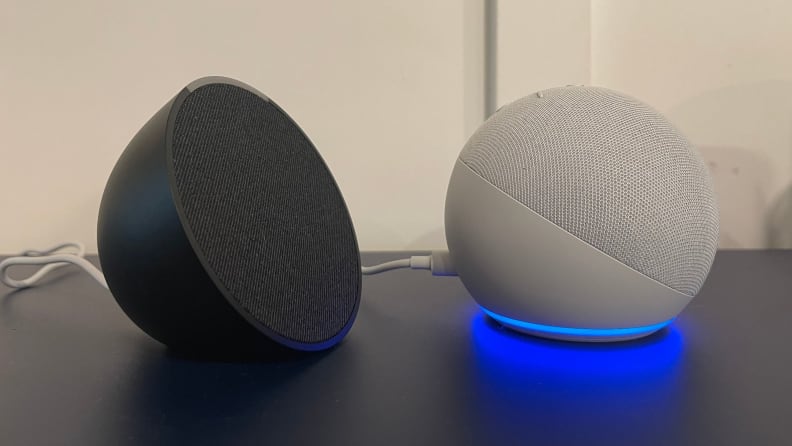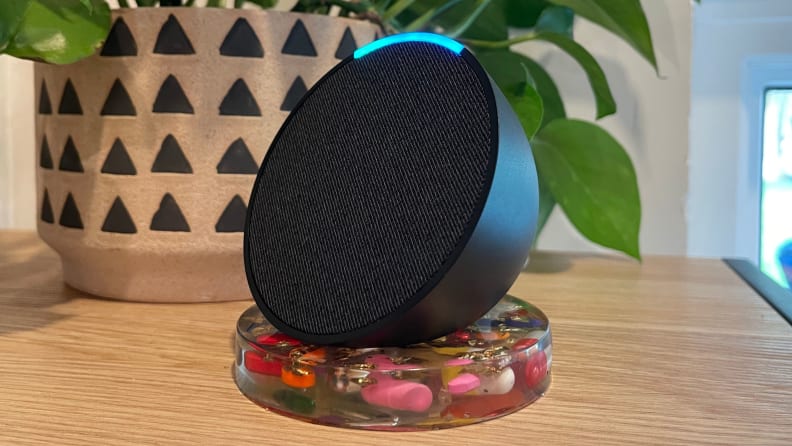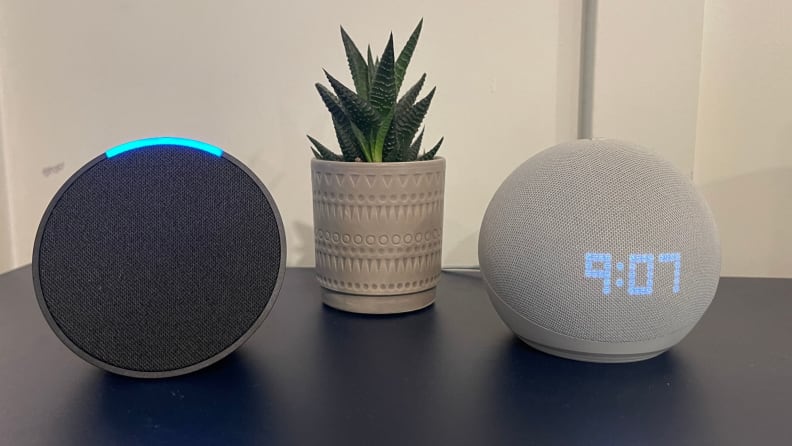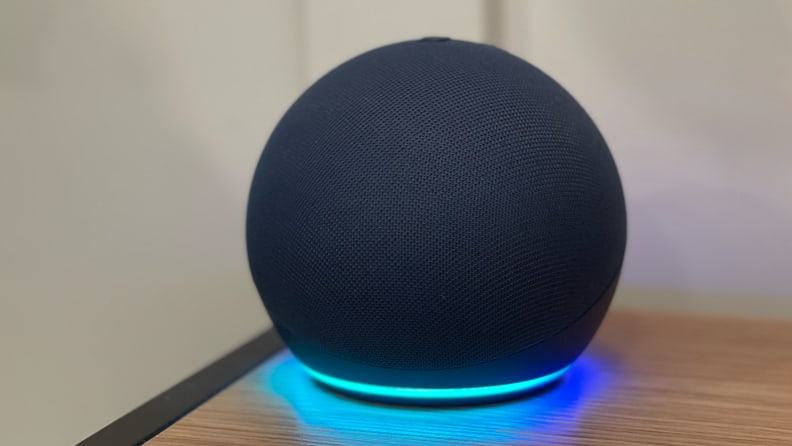The Amazon Echo lineup is getting ever larger. Unlike a company like Apple, Amazon offers a huge range of smart speakers across price points, meaning that no matter how much you want to spend, and what kind of speaker you want, there should be something in Amazon’s lineup for you, as long as you’re invested in the Alexa ecosystem. The latest in the lineup is the new Amazon Echo Pop.
The Echo Pop is now the cheapest Amazon Echo smart out there. It also happens to be only $10 cheaper than the fifth-generation Echo Dot, and offers many of the same features. Considering the fact that they’re so close in price, you might be wondering which one is right for your needs.
Here’s everything you need to know.
Performance

Credit:
Reviewed / Rachel Murphy
The fifth-gen Echo Dot has better sound quality than the Echo Pop.
The Echo Pop has a larger speaker driver than the Echo Dot, measuring in at 1.95 inches, versus 1.73 inches. But, the Echo Dot’s orb-shaped speaker design gives it a leg up for better sound, as opposed to the Echo Pop’s front-facing speaker.
But, just because a speaker driver is larger, that doesn’t mean that it’s tuned in the same way. We think the Echo Dot offers better audio quality overall, with a little more detail in the high end.
The Echo Pop really is designed for smaller spaces than the Echo Dot, and thus does not get quite as loud, or fill a room as easily.
Our pick: Echo Dot
Price

Credit:
Reviewed / Rachel Murphy
The Amazon Echo Pop is more affordable than the Amazon Echo Dot.
The Amazon Echo Pop comes in at $39.99, which makes it the cheapest Echo speaker available right now. The fifth-generation Echo Dot, on the other hand, has a price of $49.99, though it’s often discounted, and at the time of this writing was also $39.99.
It’s certainly interesting that the two speakers are so close in price, however it’s likely that even the Echo Pop will get discounts at times, especially around Prime Day, to make it even cheaper than it already is.
Our pick: Echo Pop
Get the Echo Pop on Amazon
Features and smart platform
Despite being so inexpensive, the Amazon Echo Pop thankfully still supports many of the smart features you would expect from an Echo, like the Echo Dot. For starters, it has Alexa built right in, and it’s no different than the Alexa that you’ll get on any other Echo. That means that you can use it to find out information from the web, control your smart home, and more.
Both devices have Amazon’s AZ2 processor, meaning they can process commands locally and respond to input faster.
There are some other smart features that both the Echo Pop and Echo Dot offer. For example, both devices work as a Matter controller, so they’ll fit within your modern smart home. Neither of the two devices are Thread border-routers—for that you’ll have to spring for the full-size Echo.
Both smart speakers do, however, work as a Wi-Fi extender for an Eero mesh network, which is a handy extra feature.
There are some minor differences in features though. Unlike the Echo Dot, the Echo Pop doesn’t have a temperature sensor, so it’s not quite as versatile in your smart home.
Our pick: Echo Dot
Design

Credit:
Reviewed / Rachel Murphy
The fifth-gen Echo Dot comes in an option that displays a clock interface, but the Echo Pop does not.
The design is perhaps one of the biggest differences between the Echo Pop and Echo Dot. The Echo Dot is a globe-shaped device that’s built to project audio all around it. The Echo Pop, however, is directional—it’s built to project audio out from the front, like a traditional speaker. This makes it better for placing against a wall or in a corner, for example.
The Echo Pop is available in four colors, including Charcoal, Glacier White, Lavender, and Midnight Teal.
The Echo Dot, on the other hand, comes in black, white, and deep blue. If you’re looking for a little more color, you’ll likely want to go for the Echo Pop.
The Echo Pop is a little smaller than the Echo Dot. While the Echo Dot measures 3.9 inches x 3.9 inches x 3.5 inches, the Echo Pop sits in at 3.9 inches x 3.3 inches x 3.6 inches. These Echo speakers take up a similar amount of space on a shelf, though—the size difference is anything but radical.
The Echo Dot is available in more variants though. For example, the Echo Dot has a clock display option, which costs more. There’s no such option for the Echo Pop, though.
Our pick: Echo Dot
Get the Echo Dot on Amazon
And the winner is…
Amazon Echo Dot (5th Gen)

Credit:
Reviewed / Rachel Murphy
The fifth-gen Echo Dot is a better Alexa speaker than the Echo Pop.
The Amazon Echo Dot is still superior to the Echo Pop. It has unidirectional audio, along with a temperature sensor built-in, and a clock model, for those who want one.
But that doesn’t mean that the Echo Dot is the better choice for everyone. If you could stand to save a little cash and still want the benefits of Alexa, and plan on placing the speaker in a corner or along a wall anyway, the Echo Pop is a better choice for your needs.
If you simply want a solid Echo speaker to work with your smart home, and don’t mind spending the extra cash, it’s probably worth simply springing for the good ol’ Echo Dot.
The product experts at Reviewed have all your shopping needs covered. Follow Reviewed on Facebook, Twitter, Instagram, TikTok or Flipboard for the latest deals, product reviews, and more.
Prices were accurate at the time this article was published but may change over time.











